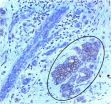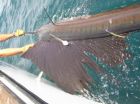(Press-News.org) JUPITER, FL, December 22, 2010 – A scientist from the Florida campus of The Scripps Research Institute has discovered a molecular switch that controls the synthesis of ribosomes. Ribosomes are the large machineries inside all living cells that produce proteins, the basic working units of any cell. These new findings offer a novel target for potential treatments for a range of diseases, including cancer.
The study is published in the December 24, 2010 edition of the Journal of Molecular Biology.
The study identified the molecular switch, essentially formed by a small sequence of RNA, that controls a critical part of ribosome synthesis to allow for strict, albeit temporary, regulation of the process.
"These kinds of switches in RNA are thought to be slow acting," said Katrin Karbstein, an assistant professor in the Department of Cancer Biology at Scripps Florida who helped lead the study. "That suggests a point where we might intervene to modify the process – then you could potentially shut down the pathway, because if you don't produce ribosomes, you cannot make proteins. Thus, cells can't grow. That would be a desirable outcome in cancer, for example."
This slowness may be there precisely so these regulatory points can be introduced for cells to downregulate growth when nutrition is scarce.
"Perhaps, nature has found a way to exploit RNA's Achilles' heel – its propensity to form alternative structures that can lead to protein misfolding, which, in turn, can cause diseases ranging from Alzheimer's to diabetes," Karbstein said. "Nature might be using this to stall important biological processes and allow for quality control and regulation."
The synthesis of proteins involves ribosomes, large macromolecular machines required for cell growth in all organisms. Ribosomes read the genetic code carried by messenger RNA and then catalyze or translate that RNA code into proteins within cells, assembling them from amino acids.
To produce mature ribosomal RNAs (rRNAs), the catalysts that control protein synthesis in all cells, the body first needs perfectly formed intermediate or pre rRNAs, which can be further processed into fully functioning ones. The intermediate form is produced as an RNA transcript that is cleaved or cut in multiple steps to produce mature rRNA.
"While we believe that this switch is essential for ribosome assembly, it seems unlikely that this is the only event that regulates cleavage," Karbstein said. "However, tight regulation of ribosome synthesis is essential to ensure the structural integrity of mature ribosomes."
Cutting Extra Material
The ribosomal RNA that is transcribed has extra material in it, Karbstein said, so it is necessary to cut it down – that's why these cuts or cleavages are so essential to the process of producing the final rRNA product.
The study also suggests RNA itself exploits its own natural ability to form these stable structural switches to order and regulate various RNA-dependent biological processes.
"What is interesting," Karbstein said, "is that as the organism becomes more complex, the number of cleavages needed increases. This may make the process more accurate and that may be an evolutionary advantage, but even in bacteria this cutting is not done in a simple way. We still don't know exactly why that is."
Perhaps these strictly ordered cleavage steps are introduced to produce singularly perfect intermediates, she added. This is important because cleavage is an irreversible energy-releasing process with the potential to shift the landscape of assembly towards the final product. As a result, cleavage steps should be carefully controlled and should only occur if the assembly intermediate is correct.
"Ribosomes make mistakes rarely, on the order of one in 10,000 amino acid changes," Karbstein said. "A lot of this accuracy depends on conversations between different parts of the ribosomes, so if the structure of the RNA isn't correct, these conversations can't happen. And that means more mistakes, and that's not good because it can lead to any number of disease states."
For now, Karbstein said she's interested in looking at small molecules that perturb the switch, and finding out if this affects the quality of the ribosomes produced.
"Certain kinds of antibiotics work by making the ribosomes produce more mistakes – it's not a huge increase but it's enough to make these cells die," she said. "Maybe we can find molecules that similarly lead to the production of 'worse' ribosomes."
###
In addition to Karbstein, Allison C. Lamanna is an author of the study, "An RNA Conformational Switch Regulates Pre-18S rRNA Cleavage" (doi:10.1016/j.jmb.2010.09.064).
The study was supported by the National Institutes of Health.
About The Scripps Research Institute
The Scripps Research Institute is one of the world's largest independent, non-profit biomedical research organizations, at the forefront of basic biomedical science that seeks to comprehend the most fundamental processes of life. Scripps Research is internationally recognized for its discoveries in immunology, molecular and cellular biology, chemistry, neurosciences, autoimmune, cardiovascular, and infectious diseases, and synthetic vaccine development. An institution that evolved from the Scripps Metabolic Clinic founded by philanthropist Ellen Browning Scripps in 1924, Scripps Research currently employs approximately 3,000 scientists, postdoctoral fellows, scientific and other technicians, doctoral degree graduate students, and administrative and technical support personnel. Headquartered in La Jolla, California, the institute also includes Scripps Florida, whose researchers focus on basic biomedical science, drug discovery, and technology development. Scripps Florida is located in Jupiter, Florida. For more information, see www.scripps.edu
END
AURORA, Colo. (Dec. 22, 2010)—A class of drugs thought to kill cancer cells may in fact block "cross talk" between the cancer cell and normal immune cells, resulting in reduced cancer growth and spread—a discovery that could significantly alter the way cancer drugs are evaluated in the future.
Researchers at the University of Colorado Cancer Center demonstrated the discovery in bladder cancer, the fifth most common cancer in the United States. Bladder cancer will kill about 14,000 Americans this year, most of whom will die as a result of the disease's spread to other ...
University Park, Pa. -- A computer program that automatically analyzes mounds of satellite images and other data could help climate scientists keep track of complex, constantly changing environmental conditions, according to an international team of researchers.
"All of the data and information that is continually collected by satellites and sensors can cause tons of problems for scientists, who simply don't have the time to analyze every pixel of every satellite image," said James Wang, professor of information sciences and technology, Penn State. "Our goal has been ...
WASHINGTON, D.C., December 22, 2010 -- What can scientists learn from watching a group of people sitting around, chatting, playing movies, reading, and happily making new friends? Quite a lot, says University of Melbourne, Australia acoustician Adam Vogel, who carefully observed this sort of group in a fatigue management study he and his colleagues describe this month in The Journal of the Acoustical Society of America.
Their report shows the effects of sustained wakefulness on speech and describes a novel method to acoustically analyze the effects of fatigue on the central ...
Gaithersburg, MD – On December 14-15, 2010, the U.S. Food and Drug Administration (FDA) convened an Advisory Panel to discuss several scientific issues that may affect the regulation of dental amalgam. At the conclusion of the hearing, the Panel voted to recommend that the FDA conduct further review of the material's safety.
The meeting comes on the heels of a July 2009 Final Rule (http://bit.ly/FDA2009FinalRule) from the FDA that reclassified dental mercury from a class I device to a class II device and designated special controls for dental amalgam, mercury and amalgam ...
PHILADELPHIA – Overexpression or hyperactivation of ErbB cell-surface receptors drives the growth of many breast cancers. Drugs, like Herceptin, that block the receptors' signals halt tumor progression in some patients. However, not all patients' tumors respond, with some becoming resistant over time. Different drugs that interfere with other steps in the signaling pathway may improve the response of patients, yet little is known about these molecules.
Now, Marcelo G. Kazanietz, PhD, professor of Pharmacology at the University of Pennsylvania School of Medicine and colleagues, ...
Researchers at The Wistar Institute announce the release of an online tool that will help scientists find "gene promoters"—regions along a DNA strand that tell a cell's transcription machinery where to start reading in order to create a particular protein. The Mammalian Promoter Database (MPromDb) integrates the genome sequencing data generated at Wistar with publicly available data on human and mouse genomics. MPromDb pinpoints known promoters and predicts where new ones are likely to be found, the researchers say.
"Several complete genome sequences are available, including ...
Researchers have discovered evidence of a distinct group of "archaic" humans existing outside of Africa more than 30,000 years ago at a time when Neanderthals are thought to have dominated Europe and Asia. But genetic testing shows that members of this new group were not Neanderthals, and they interbred with the ancestors of some modern humans who are alive today.
The journal Nature reported the finding this week. The National Science Foundation's Behavioral and Cognitive Sciences Division partially funded the research.
An international team of scientists led by Svante ...
Billfish and tuna, important commercial and recreational fish species, may be more vulnerable to fishing pressure because of shrinking habitat, according to a new study published by scientists from NOAA, The Billfish Foundation, and University of Miami Rosenstiel School of Marine and Atmospheric Science.
An expanding zone of low oxygen, known as a hypoxic zone, in the Atlantic Ocean is encroaching upon these species' preferred oxygen-abundant habitat, forcing them into shallower waters where they are more likely to be caught.
During the study, published recently in ...
MADISON – To survive in a tumultuous environment, sea urchins literally eat through stone, using their teeth to carve out nooks where the spiny creatures hide from predators and protect themselves from the crashing surf on the rocky shores and tide pools where they live.
The rock-boring behavior is astonishing, scientists agree, but what is truly remarkable is that, despite constant grinding and scraping on stone, urchin teeth never, ever get dull. The secret of their ever-sharp qualities has puzzled scientists for decades, but now a new report by scientists from the ...
CORVALLIS, Ore. – Marine ecologists at Oregon State University have shown for the first time that tiny fish larvae can drift with ocean currents and "re-seed" fish stocks significant distances away – more than 100 miles in a new study from Hawaii.
The findings add credibility to what scientists have believed for some time, but until now been unable to directly document. The study also provides a significant demonstration of the ability of marine reserves to rebuild fishery stocks in areas outside the reserves.
The research was published this week in PLoS One, a scientific ...



